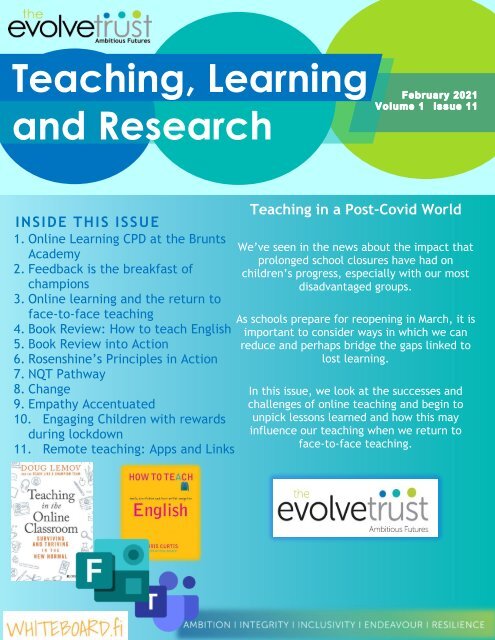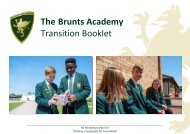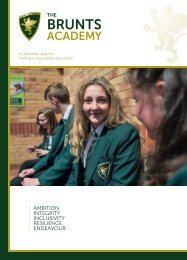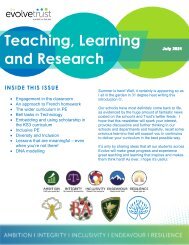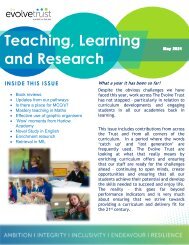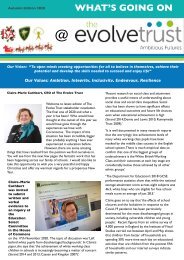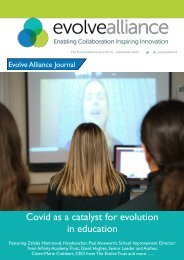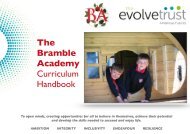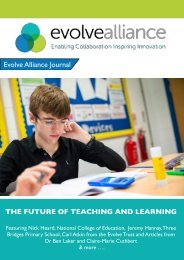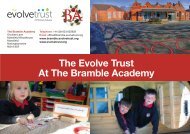Spring 1 2021 Teaching and Learning Newsletter
Teaching and learning newsletter - The Evolve Trust
Teaching and learning newsletter - The Evolve Trust
Create successful ePaper yourself
Turn your PDF publications into a flip-book with our unique Google optimized e-Paper software.
<strong>Teaching</strong>, <strong>Learning</strong><br />
<strong>and</strong> Research<br />
INSIDE THIS ISSUE<br />
1. Online <strong>Learning</strong> CPD at the Brunts<br />
Academy<br />
2. Feedback is the breakfast of<br />
champions<br />
3. Online learning <strong>and</strong> the return to<br />
face-to-face teaching<br />
4. Book Review: How to teach English<br />
5. Book Review into Action<br />
6. Rosenshine’s Principles in Action<br />
7. NQT Pathway<br />
8. Change<br />
9. Empathy Accentuated<br />
10. Engaging Children with rewards<br />
during lockdown<br />
11. Remote teaching: Apps <strong>and</strong> Links<br />
<strong>Teaching</strong> in a Post-Covid World<br />
We’ve seen in the news about the impact that<br />
prolonged school closures have had on<br />
children’s progress, especially with our most<br />
disadvantaged groups.<br />
As schools prepare for reopening in March, it is<br />
important to consider ways in which we can<br />
reduce <strong>and</strong> perhaps bridge the gaps linked to<br />
lost learning.<br />
In this issue, we look at the successes <strong>and</strong><br />
challenges of online teaching <strong>and</strong> begin to<br />
unpick lessons learned <strong>and</strong> how this may<br />
influence our teaching when we return to<br />
face-to-face teaching.
Online <strong>Learning</strong> CPD<br />
The Brunts Academy<br />
Over the course of January, staff from across the Brunts Academy have delivered<br />
CPD sessions on new <strong>and</strong> innovative strategies for online teaching <strong>and</strong> learning.<br />
Matt Hire re-introduced staff to Rosenshine’s Principles of Instruction <strong>and</strong> how this<br />
could inform online lessons, as well as outlining ways to establish online routines<br />
<strong>and</strong> expectations. Matt’s session focussed on the importance of the following:<br />
• Reviewing Material - which creates a helpful to start live lessons by<br />
activating prior knowledge linked to the topic in h<strong>and</strong>.<br />
• Questioning <strong>and</strong> Checking for Underst<strong>and</strong>ing – by using a range of<br />
technologies to question. H<strong>and</strong>s up feature, direct questioning using audio,<br />
forms <strong>and</strong> whiteboard apps that allow students’ responses to be seen.<br />
• Sequencing concepts; modelling; scaffolding - through explaining new<br />
content <strong>and</strong> concepts, making the steps small enough for students to follow.<br />
• Stages of Practice – by guiding students in the initial stages of practice so<br />
you can avoid misconceptions in learning early.<br />
Tom McDermott hosted a session on ‘<strong>Learning</strong><br />
remotely – checking learning <strong>and</strong> giving feedback’,<br />
using Microsoft Forms. Tom provided a detailed step<br />
by step guide on how to develop a Microsoft Forms<br />
Quiz <strong>and</strong> Teams Assessment, providing opportunities<br />
for students to have quality feedback on their work<br />
<strong>and</strong> to allow teachers to address misconceptions, gaps<br />
in knowledge Emily Lister <strong>and</strong> delivered develop a skills. session on the use of collaborative learning<br />
using break-out rooms on Teams. Emily highlighted the importance of<br />
breakout rooms with helping to develop group discussions, peer<br />
marking, creating group presentations <strong>and</strong> differentiated tasks.<br />
Some suggested takeaways were:<br />
• Warn the students that you will be monitoring all of their group<br />
work, conversations <strong>and</strong> chat<br />
• If students mics don’t work encourage use of the chat function<br />
instead<br />
• AVOID hang up button<br />
• Allow for a bit of “h<strong>and</strong>holding time” getting students to the right<br />
group/files etc – start small <strong>and</strong> build up to bigger tasks with it.<br />
Hally Lockwood shared the successes she has had with sharing documents on Teams. By using an exam<br />
question/statement/discussion <strong>and</strong> a word document, the teacher adds the tasks to the top of the<br />
document. Then they create a table <strong>and</strong> add each student’s name alphabetically to the table. Once this<br />
document has been created, the teacher shares the document as an attachment in the chat during a live<br />
lesson. The teacher then asks the students to click the three dots <strong>and</strong> press ‘edit in teams’. They click<br />
the same as students <strong>and</strong> share the screen with them. Finally the teacher asks the students to type their<br />
response in their box <strong>and</strong> highlight the task they have completed.
Feedback is the breakfast of<br />
champions<br />
The Brunts Academy<br />
It was lovely to see so many staff sharing their experiences with online teaching on Twitter, as a<br />
result of the Brunts CPD session.
Online <strong>Learning</strong> <strong>and</strong> the return<br />
to face-to-face teaching<br />
By Joe Morrin<br />
Doug Lemov’s ‘<strong>Teaching</strong> in the Online Classroom’ is a fantastic book which provides a variety of<br />
reassuring strategies to try with online learning, especially given the fact that teachers from across<br />
the globe have had to rapidly adapt to online teaching as a result of the p<strong>and</strong>emic. Nothing in our<br />
teacher training prepared us for this eventuality <strong>and</strong> as a result, many staff <strong>and</strong> students have had to<br />
rapidly upskill themselves with digital literacy.<br />
Doug’s book begins by highlighting the challenges faced by many students with the ‘new normal’. For<br />
example, glitchy or no internet; having to share a mobile device or having no device at all; working in<br />
a hallway as opposed to the classroom; multi-tasking <strong>and</strong> looking after siblings; screen fatigue <strong>and</strong><br />
isolation. This helps us to appreciate that these are challenging times for the students as well as for<br />
teachers.<br />
Doug breaks the book down into different sections which some of you may already use in your current<br />
teaching practice. These are:<br />
• Synchronous <strong>and</strong> Asynchronous <strong>Learning</strong><br />
• Dissolve the Screen<br />
• Culture of Attention <strong>and</strong> Engagement<br />
• Pause Points<br />
• Accountability Loops <strong>and</strong> Checking for Underst<strong>and</strong>ing<br />
• Procedures <strong>and</strong> Routines<br />
• Classroom Tech<br />
@Doug_Lemov<br />
I had the privilege of participating with the #EduBookClub to discuss Doug Lemov’s ‘<strong>Teaching</strong> in the<br />
Online Classroom. It was reassuring to hear different practitioners’ from across the UK, <strong>and</strong> beyond,<br />
discussing ways their teaching had changed in response to Doug Lemov’s book <strong>and</strong> the opportunities<br />
that had been presented by online teaching.<br />
Here are a few things that have influenced my practice as a result of reflecting on the book <strong>and</strong> online<br />
lesson delivery.<br />
• Online Etiquette- as we would be explicit with classroom behaviour, the same rules apply to online<br />
lessons <strong>and</strong> we still must reinforce these expectations<br />
• Keep lessons simple <strong>and</strong> effective- it was found that traditional PowerPoint lessons were<br />
overwhelming, especially with students who may have been late or have had connectivity issues<br />
during the lesson. Through work with the Humanities department, we had designed digital<br />
worksheets with the lesson material displayed, which works with both synchronous <strong>and</strong><br />
asynchronous lesson lessons. Here the students can see the learning journey <strong>and</strong> students are made<br />
aware of the content being delivered, which can remedy some of the technical issues. This<br />
approach has also supported the pacing <strong>and</strong> consolidation of new learning. These are submitted as<br />
a snapshot on Teams or after the lesson through the Teams assignments tab.<br />
• The structure of the lessons should have pause points which are early <strong>and</strong> often to allow students<br />
to take time away from the screen, reduce their cognitive load <strong>and</strong> to consolidate each stage of<br />
the learning.
Online <strong>Learning</strong> <strong>and</strong> the return<br />
to face-to-face teaching<br />
By Joe Morrin<br />
• Balance of synchronous <strong>and</strong> asynchronous – with A level classes students prefer the content to be<br />
recorded so they can control their own pace. During the timetabled lessons we review the<br />
learning/key points in readiness for independent practice. This has been useful for students who<br />
have been isolating <strong>and</strong> allows sufficient time to develop detailed responses.<br />
• Engagement can be achieved through questioning <strong>and</strong> multiple short activities with plenty of<br />
opportunities for consolidation. For some students, they like to have the lesson material before the<br />
live lesson to allow for them to prepare <strong>and</strong> reduce anxieties, especially with the vulnerable<br />
groups. Moreover, I have found that a balance of screen <strong>and</strong> non-screen activities help to increase<br />
this level of engagement.<br />
• Connection – for some students feeling isolated – the classroom can often be a sense of escapism.<br />
Maintaining the normality <strong>and</strong> the usual idiosyncrasies linked to the classroom, like the countdown<br />
<strong>and</strong> being upbeat, brings that personal approach. Probing for underst<strong>and</strong>ing, acknowledgement <strong>and</strong><br />
praise on <strong>and</strong> off the screen <strong>and</strong> using exemplary work goes a long way to recognise the students’<br />
work <strong>and</strong> reinforced that connection.<br />
A return to face to face teaching <strong>and</strong> future of education<br />
Like me, every practitioner will have had different experiences with online learning <strong>and</strong> this may have<br />
been informed by practice, evidence, or research. There will be successes <strong>and</strong> failures but what is<br />
important is the ability to share these ideas openly <strong>and</strong> freely. Coming back into the school will be a big<br />
change for staff <strong>and</strong> students <strong>and</strong> it’s important to collaboratively work with others to consolidate <strong>and</strong><br />
discuss the priorities for change.<br />
As mentioned earlier, it is worth noting that many teachers were not trained in online learning before<br />
lockdown <strong>and</strong>, throughout the lockdown, students <strong>and</strong> staff have upskilled themselves <strong>and</strong> this has<br />
reduced future barriers, opening up opportunities for training <strong>and</strong> development to improve technical<br />
fluency.<br />
The blended learning approach of in-person lessons <strong>and</strong> distance learning will become a key focus for a<br />
post-p<strong>and</strong>emic pedagogy. Blended learning will provide flexibility, accessibility <strong>and</strong> allow staff to track<br />
<strong>and</strong> improve student engagement <strong>and</strong> make quick gains. This will be essential in helping to address lost<br />
learning associated with persistent absenteeism. Moreover, there will be a shift from crucial to critical<br />
knowledge to ensure maximum gains are made in the short space of time.<br />
Assessment will take a different course as well <strong>and</strong> will be detached from the physical location of the<br />
school <strong>and</strong> will instead rely upon pragmatism, for example, considering multiple pieces of work <strong>and</strong><br />
using this as a measure of student success, rather than their scores from a single exam. There have been<br />
discussions about a shift to online assessments in the future <strong>and</strong> we need to upskill our teachers <strong>and</strong><br />
students for this eventuality. The online platform provides strong opportunities for self-marking quizzes<br />
<strong>and</strong> multiple assessment evidence. For example, Seneca, Sam <strong>Learning</strong> <strong>and</strong> the use of Microsoft forms<br />
<strong>and</strong> Teams assignments. This has the potential to provide greater accessibility <strong>and</strong> diagnostic feedback,<br />
especially with the more vulnerable groups <strong>and</strong> help drive improvements in teaching <strong>and</strong> learning.<br />
Finally, it is important to re-establish those connections with students <strong>and</strong> parents so they continue to<br />
be seen <strong>and</strong> valued <strong>and</strong> bring about the change needed to support the return to face-to-face teaching.
Book Review: LEGACY How to Teach<br />
English<br />
By Charlie Duckett<br />
@xris32<br />
This year, the English department are focusing their PLD around the text ‘How to Teach English’ by Chris<br />
Curtis. The book is split into ten chapters, each focusing on a different key element of the English<br />
curriculum however, Curtis acknowledges that teachers rarely have time to sit <strong>and</strong> read so, with this in<br />
mind, he has kept his explanations concise, provided a wealth of practical strategies that can be<br />
implemented immediately <strong>and</strong> focused on the importance of collaboration <strong>and</strong> sharing to make a better<br />
work-life balance. Throughout the text, Curtis focuses on the importance of engaging with students<br />
intellectually (leave the gimmicks at the door!) <strong>and</strong> the need for teachers to reflect on “whether<br />
commonly used practices are as effective as we think” – something that this text certainly makes you do!<br />
On 1 st December, I ran a department meeting focusing on the ideas <strong>and</strong> strategies discussed in Chapter<br />
1: How to Teach Poetry. Poetry has always been an element of literature that I have studied <strong>and</strong> taught<br />
with some trepidation but reading this chapter has not only helped me to underst<strong>and</strong> the power of poetry<br />
but also ignited a passion for this form of literature that I thought would never be there! Reading this<br />
chapter has completely shifted my perception of poetry <strong>and</strong> made me realise poems are simply “a feeling<br />
bottled” <strong>and</strong> “an emotional journey” <strong>and</strong> it is this emotional <strong>and</strong> personal connection which needs to be<br />
at the forefront of students’ exploration, not ‘spot the technique’! Within the meeting, we reflected on<br />
our own experiences <strong>and</strong> opinions of poetry <strong>and</strong> how we currently teach this form of literature to our<br />
students. I then highlighted my favourite elements from Chapter 1 <strong>and</strong> we discussed how we can<br />
implement these approaches into our current curriculum planning <strong>and</strong> our upcoming teaching of poetry<br />
at GCSE.<br />
Even though this text is called ‘How to Teach English’, any teacher who has to teach writing would find<br />
the chapters on essay writing, analysing texts <strong>and</strong> teaching accuracy worth a read. Curtis’ knowledge <strong>and</strong><br />
underst<strong>and</strong>ing of the ‘real’ life of a teacher shines through as well as his absolute passion <strong>and</strong> enthusiasm<br />
for his subject.
Book Review into Action: How to<br />
Teach English<br />
By Charlie Duckett<br />
Charlie’s work is a good example of the impact of evidence <strong>and</strong> research-informed practice. As a result<br />
of reading Chris Curtis’ ‘How to Teach English’, Charlie Duckett led a CPD session based on Chapter 1<br />
‘Poetry’ to disseminate the key findings from the book in order to improve poetry within the English<br />
department <strong>and</strong> to review current provision at Key Stage 3.<br />
Here are some of the highlights from the CPD session.
Rosenshine’s Principles in Action<br />
By Helen Taylor<br />
A number of teachers from across the Trust participated in Tom Sherrington’s webinar earlier this<br />
half term, focussing on how Rosenshine’s principles continue to apply in an online learning<br />
environment. Drawing students into the lesson at the beginning was pivotal to their engagement,<br />
repeatedly using first names <strong>and</strong> praising students for their contributions. Sherrington reiterated<br />
the need to check for underst<strong>and</strong>ing promoting a variety of strategies including cold-calling,<br />
providing a reminder to increase the amount of wait or response time to allow students to process<br />
the information <strong>and</strong> reply verbally or via the chat facility. Sherrington suggested using multiple<br />
choice questions <strong>and</strong> whiteboards to increase whole-class responses. When planning the sequencing<br />
of concepts, modelling <strong>and</strong> scaffolding it was considered good practice to use videos that could be<br />
paused <strong>and</strong> replayed offering repetition <strong>and</strong> subsequently consolidation of underst<strong>and</strong>ing. Teachers<br />
were encouraged to continue to provide exemplars <strong>and</strong> success criteria to support students,<br />
identifying what the work might look like when it is completed. Sherrington discussed how<br />
reviewing material order to commit knowledge to the long-term memory could still be achieved<br />
successfully through the use of quizzing, summarising <strong>and</strong> mapping. Sherrington discussed the<br />
means of participation as the key to its success showcasing the merits of google forms. A blended<br />
semi-synchronous approach to the various stages of practice was considered to be most effective<br />
with a model of live introductions, independent practice <strong>and</strong> live recap. It was heartening to<br />
discover how proactive Brunts Academy have been in their endeavour to continue to provide<br />
students with high quality learning experiences, effectively adapting their teaching practice since<br />
the beginning of lockdown 1 to incorporate these principles into their virtual classrooms.<br />
A recording of the session is available at:<br />
https://www.youtube.com/watch?v=0xrXfvWn6r0&feature=youtu.be<br />
@teacherhead
NQT Pathway<br />
By Helen Taylor<br />
In the current climate it’s more pertinent than ever to control the controllables! In the latest CPD<br />
session our NQTs <strong>and</strong> trainee teachers considered what’s the same <strong>and</strong> what is different about<br />
teaching in a virtual world. They used whiteboardfi to record their initial thoughts…<br />
Same<br />
• Meet & Greet<br />
• Bell Task/Starter<br />
• Modelling e.g. example-pairs<br />
• Scaffolding<br />
• Opportunities for<br />
practice/consolidation<br />
• Questioning<br />
• Use of KO<br />
• Plenary<br />
• End & Send<br />
• Homework<br />
Different<br />
• Student engagement<br />
• Behaviour<br />
• Lack of materials at home for<br />
students<br />
• Means of participation<br />
• Accuracy of assessment of<br />
underst<strong>and</strong>ing<br />
• Supporting struggling students<br />
• Detail in planning/preparing<br />
lessons<br />
In true collaborative style they spent time supporting each other in identifying innovative solutions to<br />
issues that had arisen in their lessons. Art & Design school direct trainee, Nicolle Watson, utilised her<br />
expertise with youtube to create videos to model techniques that she could signpost students to both<br />
in <strong>and</strong> out of lessons. On a similar theme, Science teacher, Dan Chesman considered how to best<br />
support students with identified misconceptions through exploring the use of voice recordings within<br />
powerpoint. Primary teacher, Jenna Clark identified children in Y3 with SEN needs struggling to<br />
engage with learning at home, creative ideas included providing a structured timetable for each day<br />
<strong>and</strong> celebrating the daily successes <strong>and</strong> achievements with reward stickers that could be issued by<br />
parents. Georgia Archer, Drama teacher offered advice to fellow NQT Charlotte O’Sullivan, English<br />
Teacher, on how to effectively encourage students to read aloud. Strategies included uploading<br />
material as a PDF prior to the lesson to give students time to familiarise themselves with the content<br />
as well as utilising quick paced games <strong>and</strong> competitions to increase verbal responses <strong>and</strong> aid<br />
participation. I look forward to hearing the success of these strategies in due course.<br />
@helentaylor0906
Change<br />
By Mica Coleman Jones<br />
The current p<strong>and</strong>emic has increased confusion, <strong>and</strong> elevated fear <strong>and</strong> anxiety for everyone. Inevitably,<br />
this has brought additional challenges for people who ordinarily become unsettled with change. Research<br />
<strong>and</strong> anecdotal evidence tells us that this is a common experience for autistic people.<br />
For some people, adapting to change comes intuitively <strong>and</strong> without much emotional cost. For others,<br />
change, however big or small, is another reminder of the unpredictable world that they live in. At The<br />
Beech Academy, we know that sudden <strong>and</strong> unplanned change, for some of our pupils, can cause emotional<br />
distress <strong>and</strong> prevent them from being able to engage with learning. However, we also recognise that<br />
change is inevitable <strong>and</strong> part of natural life; the bus is late, the train is cancelled, we lose the people that<br />
we love, we grow physically <strong>and</strong> emotionally. If change is inevitable, we cannot prevent it, but we can<br />
prepare for how we respond to it. With this in mind, every effort has been taken to create a remote<br />
education plan which is familiar <strong>and</strong> predictable, whilst making time to talk about the changes that are<br />
happening around us <strong>and</strong> providing emotional support to all.<br />
This is not to say that autistic people are resistant to all change. We know from experience that our pupils<br />
are better able to tolerate planned changes when they have been explained <strong>and</strong> seem logical. During a<br />
recent Science lesson, introducing puberty by exploring feelings towards change <strong>and</strong> transitions, a pupil<br />
gave examples of changes they found distressing. They said, “I get really mad when I don’t know what the<br />
change is about, but if someone tells me then that’s alright.” Another pupil, in agreement, added, “Change<br />
is confusing. Lockdown has been hard.”<br />
Survey research by Pavlopoulou et al (2020) showed that whilst lockdown may potentially have increased<br />
pressure for some autistic young people, others have benefitted from less social pressure, lesser sensory<br />
challenges, <strong>and</strong> more time spent on their own interests.<br />
It is therefore not surprising that so many schools have reported challenges transitioning pupils back to<br />
school, especially with the new set of requirements to maintain social distancing. However, there are also<br />
some people who have found comfort in the tighter regulations which organise the school environment.<br />
One pupil in Year 9 said they found the one way system in school helpful, <strong>and</strong> ‘bubbles’ meant fewer<br />
pupils in shared spaces, resulting in quieter <strong>and</strong> more manageable break times.<br />
A recent school survey indicated that some pupils felt less anxious at home, <strong>and</strong> better able to engage<br />
with learning via online lessons. Why is this? What is it about their day-to-day experience of school that<br />
incites greater feelings of uncertainty <strong>and</strong> anxiety? It is imperative that we seek to answer these questions,<br />
to make the necessary modifications to our approach <strong>and</strong> the environment in order to secure the emotional<br />
stability <strong>and</strong> educational progress of the pupils, during the course of the p<strong>and</strong>emic <strong>and</strong> beyond.<br />
N<strong>and</strong>y (2012) stated, ‘Without the underst<strong>and</strong>ing that some children have greater barriers to overcome<br />
<strong>and</strong> that school is the one place where they can gain the skills, confidence <strong>and</strong> resilience they will need<br />
to overcome them, we are certain to fail the children who most need help.’<br />
In a recent twilight, exploring Attachment Theory, the staff at The Beech Academy learned about ‘The<br />
Window of Tolerance’. When you are in your Window of Tolerance, you feel like you can deal with<br />
whatever is happening in your life. You might feel stress or pressure, but it doesn’t bother you too much.<br />
This is the ideal place to be, <strong>and</strong> is the optimal zone for engagement <strong>and</strong> learning. Ultimately, people do<br />
not learn best when they are stressed or unmotivated.
Change<br />
By Mica Coleman Jones<br />
Increased stress <strong>and</strong> heightened anxiety, can lead to feelings of panic which may trigger a meltdown or<br />
shutdown. Dr Luke Beardon (2017) describes a meltdown as a state where a person demonstrates<br />
behaviours that appear to be out of context as a reaction to the situation, <strong>and</strong> may be harmful (to<br />
oneself or others or the environment), <strong>and</strong> shutdown as a passive reaction. The latter appears to be less<br />
problematic, but the reality is that a person who shuts down spends huge levels of energy trying to avoid<br />
a meltdown <strong>and</strong> only defers the stress to a later point. This is often referred to as ‘The Coke Bottle<br />
Effect’. At this point you might think about the pupil who appears to be coping fine in school, but<br />
behaviours that are destructive <strong>and</strong> challenging are reported by people at home. Historically, schools<br />
have wrongfully directed these parents <strong>and</strong> carers to behaviour management style workshops, instead<br />
of actively embedding the anxiety reducing approaches that would prevent a pupil from this type of<br />
burnout.<br />
One approach that has been used to support pupils to recognise, <strong>and</strong> respond to, their emotional state,<br />
is Zones of Regulation (or Zones for short). This has been introduced to our Nurture classes, Year 7 <strong>and</strong><br />
Year 8, <strong>and</strong> the feedback so far has been extremely positive.<br />
The Zones of Regulation is an evidence-based practice <strong>and</strong> forms part of our holistic approach to<br />
positively supporting behaviour in school. It provides staff with a framework to teach pupils the skills<br />
needed for self-regulation <strong>and</strong> emotional control, leading to greater independence in managing own<br />
emotions <strong>and</strong> behaviour.
Change<br />
By Mica Coleman Jones<br />
Self-regulation is something that we all continually work on, even when we are not aware of it. Take a<br />
moment to think about the various things you do to regulate yourself when you are feeling tired, frustrated,<br />
anxious, <strong>and</strong> so on. The ability to self-regulate comes naturally to some, but for others it is a skill that needs<br />
to be taught. When we teach Zones at The Beech Academy, we acknowledge with pupils that it can be<br />
contextually appropriate to feel negative emotions. We all experience trying circumstances each day, but<br />
how we respond to those negative emotions is what matters.<br />
As referenced in the Window of Tolerance diagram, each of the four Zones describes a different category<br />
of emotions:<br />
The Red Zone is used to describe extremely heightened states of alertness <strong>and</strong> intense emotions. A person<br />
may be elated or experiencing anger, rage, explosive behaviour, devastation, or terror when in the Red<br />
Zone.<br />
The Yellow Zone is also used to describe a heightened state of alertness <strong>and</strong> elevated emotions; however,<br />
one has more control when they are in the Yellow Zone. A person may be experiencing stress, frustration,<br />
anxiety, excitement, silliness, the wiggles, or nervousness when in the Yellow Zone.<br />
The Green Zone is used to describe a calm state of alertness. A person may be described as happy, focused,<br />
content, or ready to learn when in the Green Zone. This is the zone where optimal learning occurs.<br />
The Blue Zone is used to describe low states of alertness <strong>and</strong> down feelings such as when one feels sad,<br />
tired, sick, or bored.<br />
Pupils have each been supported to think about the things they can do for themselves, or with others’ help,<br />
to return to a healthier place when they experience emotions that prevent them from being ‘ready to learn’.<br />
These strategies are referred to as ‘tools’. We also acknowledge that what one person might need when<br />
they are feeling sad may be different from what others would do, <strong>and</strong> that is what makes this approach<br />
personal to every student.<br />
Traffic light systems <strong>and</strong> behaviour charts are outdated <strong>and</strong> poorly evidenced approaches to changing<br />
behaviour. Put ‘behaviour charts’ into Google, <strong>and</strong> your search results will be flooded with articles such as<br />
‘Tear Down Your Behaviour Chart!’, ‘The Dark Side of Classroom Behaviour Management Charts’, <strong>and</strong> ‘Hey<br />
Teachers, Please Stop Using Behaviour Charts’. Behaviour charts, <strong>and</strong> other ‘carrot <strong>and</strong> stick’ approaches<br />
such as working towards cards, aim to incentivise a pupil to be compliant. However, research shows that<br />
short term compliance does not teach children to identify <strong>and</strong> underst<strong>and</strong> the emotions that are driving<br />
their behaviour. As a system, it also fails to recognise the external factors which influence behaviour. It is<br />
therefore unsurprising to see repeated behaviours, if the original conditions that allowed the behaviour to<br />
occur in the first place were unjust <strong>and</strong> unresolved.<br />
Instead of bribing pupils to complete undesirable tasks in exchange for some reward, I challenge teachers<br />
to consider how the learning in itself can become the desirable activity. For instance, our hook lessons for<br />
novel studies are great examples of ‘setting the stage for social-engagement’, which capture the interests<br />
of our pupils <strong>and</strong> encourages them to become curious learners.<br />
Recognising what can cause anxiety for autistic people <strong>and</strong> making appropriate adjustments can make a<br />
huge difference to the individual, <strong>and</strong> is required by law. As professionals, we must endeavour to<br />
underst<strong>and</strong> the autism perspective, <strong>and</strong> not fall into the trap of making assumptions. For example, pupils<br />
who are intellectually able <strong>and</strong> conversational are often assumed to be proficient in all areas of life,<br />
including emotional regulation – but this may not be the case.
Novel Change Study at the Beech Academy<br />
By Bev Cooper<br />
By Mica Coleman Jones<br />
Finally, as Beardon (2017) argues, ‘If we accept that it’s autism plus the environment that causes the<br />
anxiety, <strong>and</strong> we acknowledge that one cannot stop a person being autistic, then logic dictates that if<br />
we want that person’s anxiety to diminish, then we must change the environment.’ As Deborah Wright<br />
describes in ‘Empathy Accentuated’, sudden change <strong>and</strong> new expectations can destabilise feelings of<br />
safety <strong>and</strong> security. Changes are inevitable, <strong>and</strong> simple acts of consideration such as taking the time to<br />
give clear instructions to what has changed, how it has changed, <strong>and</strong> any action that is required by the<br />
pupil, can be enough to alleviate any anxiety that might otherwise be caused.
Empathy Accentuated<br />
By Deborah Wright<br />
Heart palpitations, sweaty palms, rasping breath: these are just some of the heightened physical emotions<br />
that I have felt during this third lockdown. Mix the heady concoction with emotional responses such as<br />
anger, despair, agitation, abject feelings of inadequacy <strong>and</strong> undiluted panic <strong>and</strong> you get some inkling as<br />
to how I felt during most of January.<br />
Now that I have taken my rollercoaster ride of emotions <strong>and</strong> had time to reflect on my turmoil of feelings<br />
I can say, beyond a shadow of a doubt, that the most prevalent, acute <strong>and</strong> dominant emotion I felt was<br />
ANGER! Yes I had almost debilitating panic attacks; yes I shed tears of sheer frustration <strong>and</strong> Yes I wanted<br />
to take the less productive choice - caused by this excessive adrenaline - <strong>and</strong> run for the hills but, <strong>and</strong><br />
here’s the thing, my obstinate, bloody-mindedness <strong>and</strong> lifelong passion for teaching would not let me.<br />
So, what was the cause of this overt anger? Quite simply the answer was - being pushed out of my comfort<br />
zone - regarding my teaching Modus oper<strong>and</strong>i after just shy of 30 years of teaching English in an actual<br />
classroom full of living, breathing students <strong>and</strong>, instead, having to get my head round teaching Zoom<br />
lessons online.<br />
Psychology professors tell us that anger serves an important purpose. For me, the primary focus of my<br />
anger i.e. what had caused this situation was now largely irrelevant; instead, the secondary focus -<br />
concentrating on the consequences – was far more important. And I did. It was a swift <strong>and</strong> uphill struggle<br />
but I now feel that I have reached the summit <strong>and</strong> conquered my largely irrational fears. I now, dare I<br />
say, actually get immense pleasure from preparing lessons <strong>and</strong> teaching them online; despite missing<br />
terribly actually having the students in the same room as me but, <strong>and</strong> I can’t emphasise this point enough,<br />
I now have a renewed underst<strong>and</strong>ing <strong>and</strong> accentuated sense of empathy regarding my own students’<br />
plethora of responses when they are faced with a task that they can’t or won’t do. Actually the<br />
conjunctions ‘can’t’ <strong>and</strong> ‘won’t’ are very closely linked, in my experience, when it comes to students<br />
accessing learning. ‘Can’t’ denotes a lack of skill whilst ‘won’t’ denotes a lack of will <strong>and</strong> yet, to me,<br />
they are flipsides of the same coin since it much easier NOT to do something that you find difficult, or<br />
nigh on impossible, whilst it is infinitely easier to stir up the will to do something that you are skilled at.<br />
Thus, faced with a task that you find extremely difficult or impossible to commute, it is easier to actually<br />
step back <strong>and</strong> ignore the task at h<strong>and</strong> <strong>and</strong> find distractions to take your mind off how this heinous task is<br />
making you feel. Historically this is what has occurred in many classrooms up <strong>and</strong> down the l<strong>and</strong>, <strong>and</strong><br />
indeed globally, <strong>and</strong> was even referenced in Shakespeare’s All the World’s a Stage in Jacque’s melancholy<br />
monologue:<br />
Then the whining schoolboy, with his satchel<br />
And shining morning face,<br />
creeping like snail unwillingly to school.<br />
You can’t imagine that Shakespeare is speaking autobiographically here since with his scholarly <strong>and</strong><br />
learned ways you can imagine him practically bouncing to school with much excited enthusiasm,<br />
alacrity <strong>and</strong> aplomb. However, whilst at school, <strong>and</strong> indeed, as a private tutor as a young man,<br />
Shakespeare must have gleaned that not many of his school boy friends or tutees shared his love for<br />
learning <strong>and</strong> that many actively despised school. Moreover, many of them would have loathed the<br />
whole process of learning <strong>and</strong> this would have been for a plethora of reasons but, largely, it would have<br />
been because they found the experience of learning, in often draconian circumstances, really difficult<br />
<strong>and</strong>, in some cases, downright impossible.
Empathy Accentuated<br />
By Deborah Wright<br />
However, even in these more enlightened times, when we are equipped with encyclopaedic knowledge<br />
of SEN requirements <strong>and</strong> how to guide <strong>and</strong> steer students who struggle with new concepts <strong>and</strong> skills, it<br />
is still sometimes easy to forget exactly how debilitating <strong>and</strong> frustrating this whole experience can be,<br />
<strong>and</strong> why individuals oftentimes vent their frustrations <strong>and</strong> anger with tears, aggression <strong>and</strong> a complete<br />
reluctance to engage with tasks.<br />
To conclude, the whole experience of this third lockdown - <strong>and</strong> the prerequisite processes needed to<br />
ensure that my online lessons both run smoothly <strong>and</strong> are user friendly for my students – have taught me<br />
three invaluable lessons. Foremost, never lose sight of what our students must experience when they<br />
are coping with a completely new area of learning which may trigger a myriad of negative emotions.<br />
Secondly, continue to nurture, feed <strong>and</strong> develop your own empathy since it is a most invaluable tool<br />
both in <strong>and</strong> outside the classroom <strong>and</strong> finally, despite the adage that features a new trick <strong>and</strong> an old<br />
dog, it is NEVER too late to learn, use <strong>and</strong> appreciate a new skill.
Engaging children with rewards<br />
during lockdown<br />
By John Richardson<br />
<strong>Teaching</strong> has changed.<br />
<strong>Learning</strong> has changed.<br />
School has changed.<br />
Once busy classrooms are now deserted spaces bereft of the spark of pupils grappling with new <strong>and</strong><br />
exciting concepts. Lining up before school has become patiently waiting in a Zoom waiting room.<br />
Breaktime is spent alone, rather than socialising on the playground. Sitting surrounded by friends at<br />
lunchtime has been replaced by a meal at home. Crucially, the daily interaction between pupils <strong>and</strong><br />
staff is limited to short bursts of live, online learning divided by an electronic device.<br />
So yes, teaching has changed.<br />
However, here at Bramble we are doing everything we can to make the new normal as much like the<br />
‘old’ normal as possible. This has not been easy, but every decision that is made in school has this as a<br />
huge consideration. One such decision revolved around ‘Hot Chocolate Friday’.<br />
‘Hot Chocolate Friday’ is a celebration that takes place every Friday during breaktime. Pupils are<br />
nominated by their class teacher for showing our Core Values during that week. They meet with a<br />
member of SLT to enjoy a hot chocolate <strong>and</strong> a biscuit <strong>and</strong> show off some of their work. In its current<br />
format, this is unable to go ahead. An easy decision to wait until school is reopened to all pupils could<br />
have been taken – but that wouldn’t have been the right decision. So we adapted.<br />
We know how much it means to our pupils to be nominated for Hot Chocolate Friday so we had to find a<br />
way to keep this going. We decided that pupils could still be nominated <strong>and</strong> this would be shared with<br />
each class. But this didn’t feel like enough. We decided to send out a certificate to each nominated<br />
pupil each week. But we still felt we could do more.<br />
If pupils couldn’t be in school for their hot chocolate, we would have to take the hot chocolate to them.<br />
Parcels are made up for each nominated child with everything they need for a hot chocolate<br />
celebration. A recyclable cup, hot chocolate powder, some chocolate buttons, marshmallows, a<br />
chocolate bar, their achievement badge <strong>and</strong> certificate of achievement. These are delivered to the<br />
nominated pupils each Thursday.<br />
An additional online meeting is created every week <strong>and</strong> the pupils are invited to join the SLT to show off<br />
their work on a Friday – just as they did before lockdown.<br />
I knew that this would require considerable additional effort for many school staff <strong>and</strong> would be asking<br />
them to go above <strong>and</strong> beyond their job description, but I also knew that the children would appreciate it.<br />
What I didn’t realise was just how much they would appreciate it.
Engaging children with rewards<br />
during lockdown<br />
By John Richardson<br />
Any staff who have had the privilege of delivering the hot chocolate parcel have their own story to tell.<br />
Pupils are thrilled <strong>and</strong> overjoyed when they find out they have been nominated. Reactions vary from a<br />
smile that spreads from one ear to the other, running as fast as possible up <strong>and</strong> down the street, <strong>and</strong><br />
jumping up <strong>and</strong> down to an uncontrollable squealing that is still audible as the deliverer drives away. This<br />
unbridled joy spreads into the online session on a Friday. Parents <strong>and</strong> pupils sit together with the child<br />
enjoying their hot chocolate <strong>and</strong> showing pride in the work they have produced in the previous week. It<br />
genuinely is the highlight of the week for me.<br />
Home schooling can be very difficult <strong>and</strong> stressful for many families. There is considerable additional<br />
effort required from staff in school to make ‘Virtual Hot Chocolate Friday’ happen, but the pride shown<br />
by the nominated pupils <strong>and</strong> their parents makes that effort pale into insignificance.<br />
In these strangest of times, keeping some normality (whatever that is these days) can have a huge impact<br />
on those pupils learning remotely, their mental health <strong>and</strong> achievements.<br />
Never undervalue the impact of a sprinkling of positivity – <strong>and</strong> chocolate.<br />
Take some time this week to think about what you can do to make a positive difference to our children<br />
<strong>and</strong> young people while we are working largely remotely.<br />
A small gesture can make a huge difference to the right person at the right time.
Remote <strong>Teaching</strong>: Apps <strong>and</strong> Links<br />
Credit to Mr Gordon<br />
@MrAWGordon_
Remote <strong>Teaching</strong>: Apps <strong>and</strong> Links<br />
Credit to Mr Gordon<br />
@MrAWGordon_


